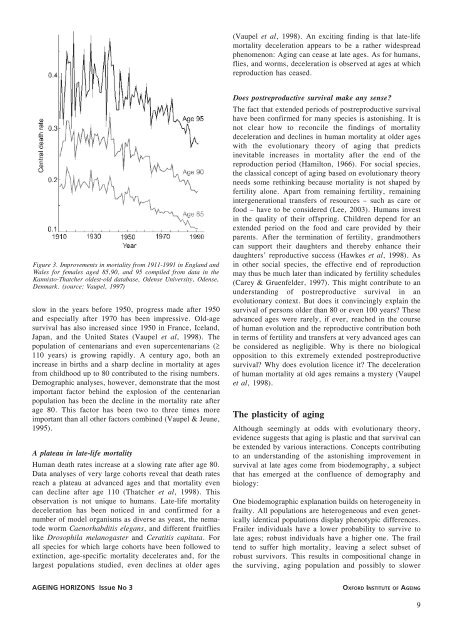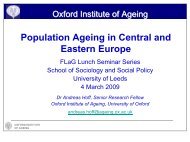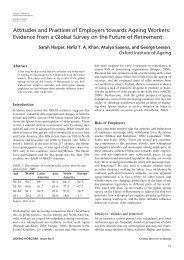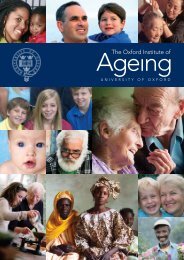Broken limits to life expectancy - by Vaupel and v.Kistowksi
Broken limits to life expectancy - by Vaupel and v.Kistowksi
Broken limits to life expectancy - by Vaupel and v.Kistowksi
You also want an ePaper? Increase the reach of your titles
YUMPU automatically turns print PDFs into web optimized ePapers that Google loves.
(<strong>Vaupel</strong> et al, 1998). An exciting finding is that late-<strong>life</strong><br />
mortality deceleration appears <strong>to</strong> be a rather widespread<br />
phenomenon: Aging can cease at late ages. As for humans,<br />
flies, <strong>and</strong> worms, deceleration is observed at ages at which<br />
reproduction has ceased.<br />
Figure 3. Improvements in mortality from 1911-1991 in Engl<strong>and</strong> <strong>and</strong><br />
Wales for females aged 85,90, <strong>and</strong> 95 compiled from data in the<br />
Kannis<strong>to</strong>-Thatcher oldest-old database, Odense University, Odense,<br />
Denmark. (source: <strong>Vaupel</strong>, 1997)<br />
slow in the years before 1950, progress made after 1950<br />
<strong>and</strong> especially after 1970 has been impressive. Old-age<br />
survival has also increased since 1950 in France, Icel<strong>and</strong>,<br />
Japan, <strong>and</strong> the United States (<strong>Vaupel</strong> et al, 1998). The<br />
population of centenarians <strong>and</strong> even supercentenarians (≥<br />
110 years) is growing rapidly. A century ago, both an<br />
increase in births <strong>and</strong> a sharp decline in mortality at ages<br />
from childhood up <strong>to</strong> 80 contributed <strong>to</strong> the rising numbers.<br />
Demographic analyses, however, demonstrate that the most<br />
important fac<strong>to</strong>r behind the explosion of the centenarian<br />
population has been the decline in the mortality rate after<br />
age 80. This fac<strong>to</strong>r has been two <strong>to</strong> three times more<br />
important than all other fac<strong>to</strong>rs combined (<strong>Vaupel</strong> & Jeune,<br />
1995).<br />
A plateau in late-<strong>life</strong> mortality<br />
Human death rates increase at a slowing rate after age 80.<br />
Data analyses of very large cohorts reveal that death rates<br />
reach a plateau at advanced ages <strong>and</strong> that mortality even<br />
can decline after age 110 (Thatcher et al, 1998). This<br />
observation is not unique <strong>to</strong> humans. Late-<strong>life</strong> mortality<br />
deceleration has been noticed in <strong>and</strong> confirmed for a<br />
number of model organisms as diverse as yeast, the nema<strong>to</strong>de<br />
worm Caenorhabditis elegans, <strong>and</strong> different fruitflies<br />
like Drosophila melanogaster <strong>and</strong> Ceratitis capitata. For<br />
all species for which large cohorts have been followed <strong>to</strong><br />
extinction, age-specific mortality decelerates <strong>and</strong>, for the<br />
largest populations studied, even declines at older ages<br />
Does postreproductive survival make any sense?<br />
The fact that extended periods of postreproductive survival<br />
have been confirmed for many species is as<strong>to</strong>nishing. It is<br />
not clear how <strong>to</strong> reconcile the findings of mortality<br />
deceleration <strong>and</strong> declines in human mortality at older ages<br />
with the evolutionary theory of aging that predicts<br />
inevitable increases in mortality after the end of the<br />
reproduction period (Hamil<strong>to</strong>n, 1966). For social species,<br />
the classical concept of aging based on evolutionary theory<br />
needs some rethinking because mortality is not shaped <strong>by</strong><br />
fertility alone. Apart from remaining fertility, remaining<br />
intergenerational transfers of resources – such as care or<br />
food – have <strong>to</strong> be considered (Lee, 2003). Humans invest<br />
in the quality of their offspring. Children depend for an<br />
extended period on the food <strong>and</strong> care provided <strong>by</strong> their<br />
parents. After the termination of fertility, gr<strong>and</strong>mothers<br />
can support their daughters <strong>and</strong> there<strong>by</strong> enhance their<br />
daughters’ reproductive success (Hawkes et al, 1998). As<br />
in other social species, the effective end of reproduction<br />
may thus be much later than indicated <strong>by</strong> fertility schedules<br />
(Carey & Gruenfelder, 1997). This might contribute <strong>to</strong> an<br />
underst<strong>and</strong>ing of postreproductive survival in an<br />
evolutionary context. But does it convincingly explain the<br />
survival of persons older than 80 or even 100 years? These<br />
advanced ages were rarely, if ever, reached in the course<br />
of human evolution <strong>and</strong> the reproductive contribution both<br />
in terms of fertility <strong>and</strong> transfers at very advanced ages can<br />
be considered as negligible. Why is there no biological<br />
opposition <strong>to</strong> this extremely extended postreproductive<br />
survival? Why does evolution licence it? The deceleration<br />
of human mortality at old ages remains a mystery (<strong>Vaupel</strong><br />
et al, 1998).<br />
The plasticity of aging<br />
Although seemingly at odds with evolutionary theory,<br />
evidence suggests that aging is plastic <strong>and</strong> that survival can<br />
be extended <strong>by</strong> various interactions. Concepts contributing<br />
<strong>to</strong> an underst<strong>and</strong>ing of the as<strong>to</strong>nishing improvement in<br />
survival at late ages come from biodemography, a subject<br />
that has emerged at the confluence of demography <strong>and</strong><br />
biology:<br />
One biodemographic explanation builds on heterogeneity in<br />
frailty. All populations are heterogeneous <strong>and</strong> even genetically<br />
identical populations display phenotypic differences.<br />
Frailer individuals have a lower probability <strong>to</strong> survive <strong>to</strong><br />
late ages; robust individuals have a higher one. The frail<br />
tend <strong>to</strong> suffer high mortality, leaving a select subset of<br />
robust survivors. This results in compositional change in<br />
the surviving, aging population <strong>and</strong> possibly <strong>to</strong> slower<br />
AGEING HORIZONS Issue No 3<br />
OXFORD INSTITUTE OF AGEING<br />
9





![ORAL PRESENTATIONS [pdf] - Oxford Institute of Ageing](https://img.yumpu.com/37918222/1/184x260/oral-presentations-pdf-oxford-institute-of-ageing.jpg?quality=85)




